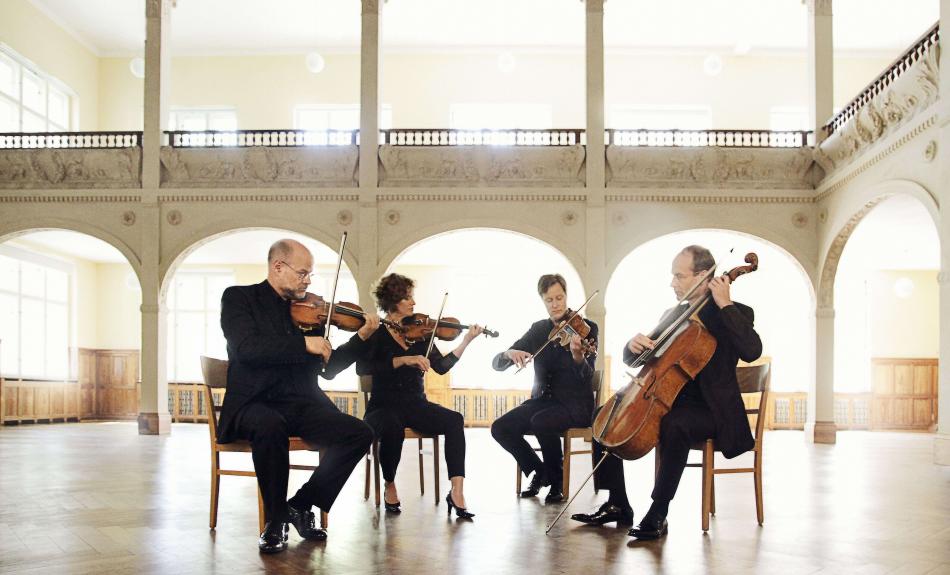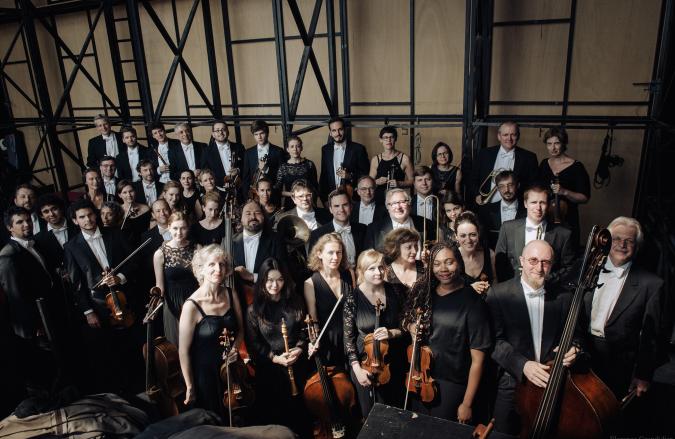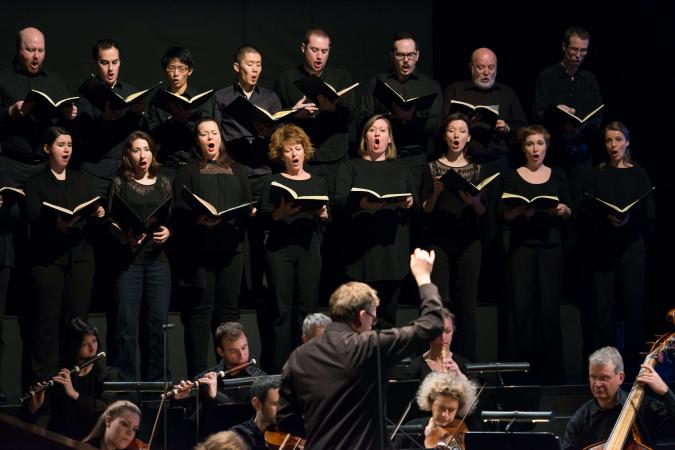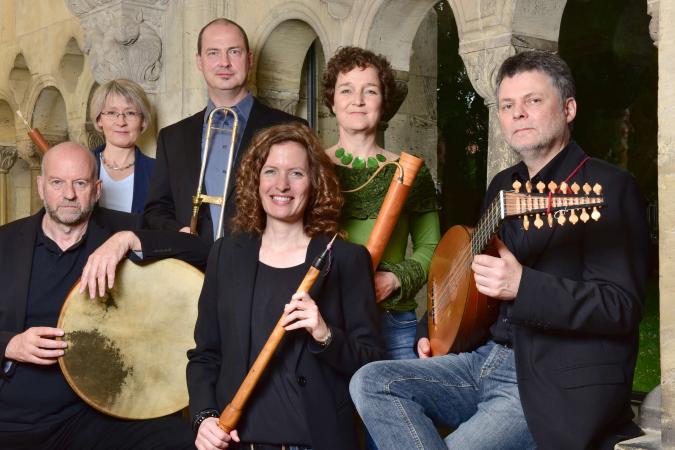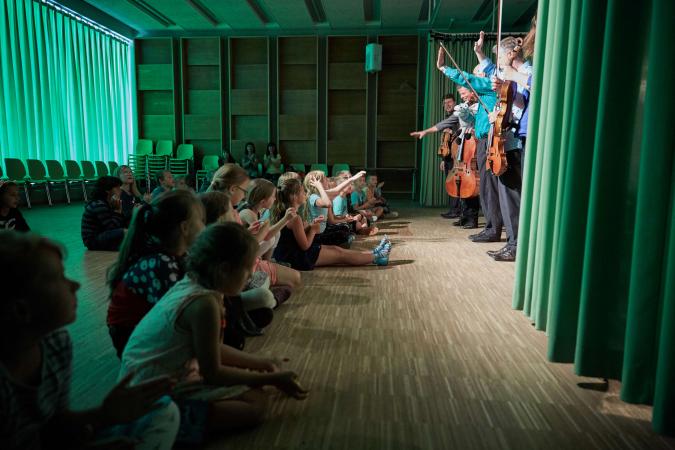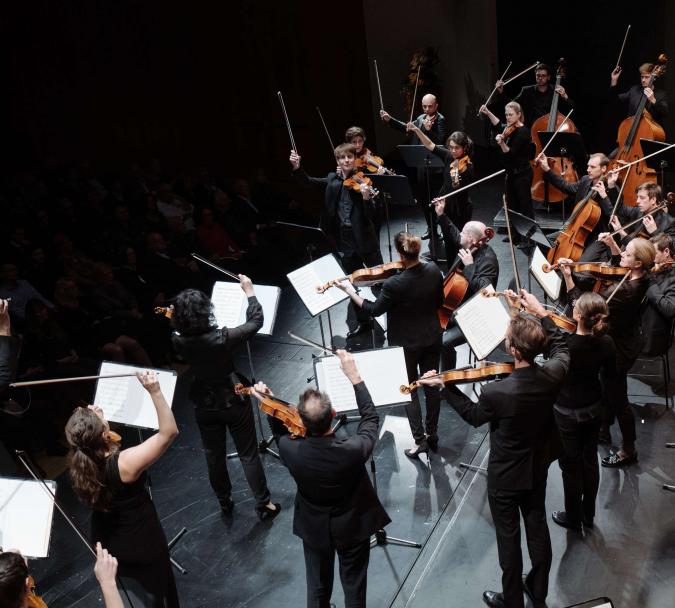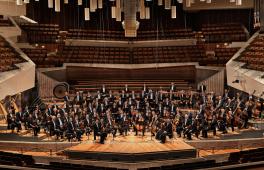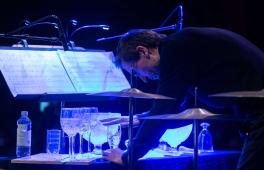In addition to publicly funded orchestras, Germany has hundreds of independ ent ensembles and orchestras of various sizes, with variable combinations of musicians and distinctive repertoires, especially in the fields of early music and contemporary music. They form a broad-based foundation for diverse and differentiated concert activities and are found throughout the entire country. That said, their activities tend to be centred in large cities and urban conglomerations. There are more than 40 contemporary music ensembles in Berlin alone, and some 25 in Cologne specialising in early music. A similar density of specialist ensembles can be found in Munich, Hamburg and Freiburg im Breisgau. Moreover, independent chamber orchestras, often with programmes based around the baroque, pre-classical and classical-romantic repertoires, frequently settle in regions with especially rich musical traditions, such as Central Germany.
Organisational structure and financing
The term ‘independent ensembles and orchestras’ refers to professional musical formations whose members work freelance and are usually involved in the ensemble as ‘shareholders’. [1] Quite often they adopt the legal status of a civil-law partnership (Gesellschaft des bürgerlichen Rechts, GbR). This is an eminently practical arrangement; it has few formal strictures, and is inexpensive and bureaucratically simple to handle. But there are also artistic considerations, for each shareholder has wide-ranging powers of co-determination. On the other hand, this legal status is fraught with dangers, since a partnership’s members are personally liable for its total debts. The shareholders of an ensemble may in clude either all its members (as with Concerto Köln and the Akademie für Alte Musik in Berlin) or several of its leading musicians.
‘The few prominent and comparatively well-funded ensembles are offset by a multitude of other formations whose working conditions can at best be described as precarious.’
Even outstanding and highly prolific ensembles, such as ensemble recherche in Freiburg or Ensemble Modern, are GbRs. The latter adopted this status after extricating itself in 1987 from the organisational struc tures of the Young German Philharmonic from which it emerged. For those that have a management, the members of the management staff are usually hired by the GbR rather than forming part of it. In some cases, as with ensemble recherche, the management also forms a second GbR connected with the ensemble via an agency contract. Often ensembles function in the legal status of a registered association (eingetragener Verein, e. V.), which not only gives them the benefits of a non-profit organisation but also limits members’ liability to the association’s assets, provided that the members are not personally liable to the full extent. Examples in clude the Cologne Chamber Orchestra, the Balthasar Neumann Choir and Ensemble, the Heidelberg Symphony Orchestra and Ensemble Zeitsprung. Various permutations of e. V. structure, GbR and GmbH (Gesellschaft mit beschränkter Haftung, or limited liability company) also allow some ensembles to deal with different forms of income (donations, proceeds from CD sales, etc.). In many cases, however, musicians play in an ensemble without explicitly regulating its legal status. This is especially true of very small formations (duos, trios etc.) and of groups that work on a small scale. In this case individual contracts are frequently drawn up between the participants and the concert organiser concerned, or one member of the ensemble will sign these agreements on behalf of the others.
Independent ensembles have enormous importance for music in Germany, functioning as an engine for innovation and creativity. This stands in blatant contradiction to the frequently difficult conditions to which they are exposed. Rarely do they receive institutional support (unlike in France, for example). Even in the case of such ‘flagships’ as the Freiburg Baroque Orchestra or Ensemble Modern, such support makes up at most 20 to 25 per cent of their total budget. This necessitates alternative sources of income, of which, besides box office proceeds and fees from outside organisers, grants-in-aid for their own projects are particularly important. Many ensembles also try to branch out into different styles, not only for artistic rea sons, but to enlarge their financial potential. They establish promotional societies to channel local private support, and become attached to neighbouring higher education institutes, which in turn allows them to recruit suitable musicians for their own ranks.
The few prominent and comparatively well-funded ensembles are offset by a multitude of other formations whose working conditions can at best be described as precarious. Usually this highly dichotomous situation is also reflected in their organisational structures: while some ensembles have a professional management team, the administrative work of countless smaller ensembles is spread among their members, who, quite apart from their musical skills, take on such tasks as bureaucratic paperwork, bookkeeping or project management. Moreover, as the number of independent ensembles continues to grow, more and more groups compete for project funding, with publicly funded ensembles also being able to apply for spe cial grants. Even in the rare instances where core funding is granted, the amount is seldom enough to cover the operating costs of a (part-time) manage ment position or the rental of office or rehearsal space. These difficulties frequently cause the range of options to stagnate at a fairly low level. For this reason, ensembles typically give no more than five to 15 concerts a year. Their activities can also vary dras tically from year to year, as they are largely funded via applications for grants from public sources. The vast majority of ensembles are thus active primarily in their home regions while making constant efforts to expand their radius of action. Important partners for international projects are frequently the Goethe Institutes in the countries concerned.
Because of this dire financial situation, even members of large, internationally renowned ensembles are not always able to secure their livelihoods through their ensemble work, but must seek outside employment, of which the largest part is probably taken up by teaching commitments. Only a few outstanding ensembles that appear regularly at the most prestigious festivals and venues worldwide, play be tween 50 and 100 concerts annually and hold a substantial number of other events, such as workshops or outreach projects, offer their members enough to make ends meet. The close connection between renowned ensembles and festivals is especially important to both parties in this respect. The concert fees that organisers pay to Ensemble Modern and ensemble recherche, for example, are said by these groups to make up at least 50 per cent of their total income. If we add 20 to 25 per cent general funding from city, state or federal government and other project subsidies, we find these formations incomparably better off than the bulk of independent ensembles. Yet even they must struggle with insecurities owing to the relatively small percentage of core subsidies in their overall budget.
If we compare the situation of independent ensembles (whose members are often personally liable as shareholders of a GbR) with that of orchestras governed by a blanket contract (Tarifvertrag für Musiker in Konzert- und Theaterorchestern, TVK), we note a clear discrepancy in the volume of institutional funding and the econom ic risk incurred by individual members. Owing to their different financing options, the average annual income of a member of an independent ensemble, even if world-renowned, is usually far less than that of an employee in a TVK orchestra.
Given these economic drawbacks, the question arises why musicians play in independent ensembles at all. Here it is surely significant that the number of positions in publicly funded orchestras has dropped by nearly 20 per cent since 1992, [2] unlike the number of music school graduates, so that alternative fields of activity have become increasingly important. On the other hand, independent ensembles give their members far greater artistic licence, a fact that many ambitious musicians use to make a virtue of necessity. They find it attractive to pursue their artistic ambitions individually within freely constituted ensembles.
Early music ensembles
The history of the historically informed performance of early music in Ger many dates from 18 September 1954, when Cappella Coloniensis gave its first concert on period instruments in the Great Broadcasting Studio of what was then North west German Radio (NWDR) in Cologne. Seated in the audience were the incumbent president of Germany, Theodor Heuss, and federal economic minister Ludwig Erhard, lending the event great political weight. It was not until 21 September 1985 that a similar constellation arose, when Richard von Weizsäcker, in his capacity as Federal President, delivered a festive address for the Bach, Handel and Schütz Ju bilee at the Stuttgart International Festival of Music. The ensembles in these performances were the Gächinger Kantorei (likewise founded in 1954) under its director Helmuth Rilling, and the Stuttgart Bach Collegium (founded in 1965), one of the few early music ensembles that played on modern instruments. Today both Stuttgart ensembles, headed by Hans-Christoph Rademann, have renamed them selves the Gaechinger Cantorey and take their bearings from the historically informed performance practice established in Germany by the above-mentioned Cappella Coloniensis: the musicians play either on historical instruments or on modern reconstructions and make their decisions on the basis of historical sources, thereby creating performances as faithful as possible to the originals. Often the groups prepare editions on their own or in conjunction with musicologists.
A formative event for Germany’s early music scene was the appearance of Musica Antiqua Köln under Reinhard Goebel in 1973, the first genuinely independent ensemble to attain worldwide fame. Today the German Music Information Centre lists more than 200 professional early music ensembles in Germany, a broad-based scene of historically informed performance practice that can look back on an impressive and successful 60-year history. If its style of performance and struggles with historical instruments initially drew smirks from established ensembles, its musical standards have long come to equal, and sometimes to far surpass, those of publicly funded orchestras. In the meantime TVK orchestras have largely delegated baroque music and the early classical repertoire to the early music ensembles or hire specialists from the early music scene for their own pro grammes. Several opera houses, including the Berlin State Opera ‘Unter den Linden’, the Karlsruhe State Theatre and the Magdeburg Theatre, likewise engage specialist ensembles for their baroque productions or festivals. Early music specialists are also hired to conduct at other opera houses or to supply local opera orchestras with continuo players.
With its artistic achievements, pioneering spirit and fresh discoveries, the early music scene has ensured that the spectrum of today’s musical life has expanded enormously. Early music encompasses the nearly 1000 years of music history between Gregorian chant and the romantic symphony. It includes not only regionally significant works that have long passed unnoticed, but also music from other European and even non-European countries.
In this sense, early music has truly arrived in the great concert series and ven ues. That it is now present in all areas of musical life, from normal concert operations and festivals to the CD market and radio broadcasts, and at practically every higher education institute, is a fundamental achievement of the ensembles and artists who have specialised in this area. In the course of this devel opment, several regional hubs have emerged in Germany. Cologne, for example, is sometimes called the capital of early music. The Cologne Early Music Society currently has 90 active ensembles and musicians in its membership. This density is related to the roles played by Cologne’s University of Music and Dance and by West German Radio (WDR), which has functioned as a sort of midwife and patron for many ensembles since the 1960s. Every higher education institute where early music is cultivated has given rise to corresponding ensembles. This is most impressively apparent in Basel with its Schola Cantorum Basiliensis, which constantly spawns new ensemble activities in its surroundings, many of which lastingly enrich Germany’s early music scene. Similarly, nationally successful ensembles stimulate the scenes where they happen to be headquartered, as witness Freiburg and Berlin.
But following a heyday that made all of this possible – a period extending well into the 1990s – musicians now face increasingly difficult conditions. The CD market has collapsed; radio has largely withdrawn from its own productions and focuses on live recordings; moreover, early music ensembles not only augment the offerings of publicly funded orchestras in today’s concert life, they also compete with each other. It was in response to this state of affairs, among other things, that the Cologne Early Music Society was founded in 2011. It now operates the Cologne Early Music Centre (Zentrum für Alte Musik Köln, or ZAMUS), whose operating costs are partly defrayed by a subsidy from the city and a grant-in-aid from the state of North Rhine-Westphalia as well as foundations and sponsors. Opened in 2012, ZAMUS is unique in Germany. Not only does it offer its members valuable logistic support in the form of rehearsal and office space and instrument loans, it has also become a meeting place for artistic encounters. It is also the site of the annual Cologne Early Music Festival, which, lacking historical venues, has opened up new performance locations. Much the same can be found in Freiburg in the so-called Ensemble House, which likewise opened in 2012. Here the Freiburg Baroque Orchestra and ensemble recherche have their headquarters, with rehearsal rooms and orchestral offices. The courses and workshops of the Ensemble Academy elevate the contacts and interaction between early and contemporary music into a governing principle.
Events, networking and synergies
Today Germany has some 60 festivals of professional stature and nationwide importance that focus primarily on early music. [3] They have various funding options for their concerts and must plan their programmes to cover all costs wherever possible. This applies to offerings from Germany’s public broadcasters, such as the Herne Early Music Days (founded by WDR in 1976) or the series ‘Das Alte Werk’ (NDR), as well as such private initiatives as the Regensburg Early Music Days, found ed in 1984 by three former choristers of the Regensburg Domspatzen boys’ choir and now one of the most important festivals of its kind in the world. A number of festivals have arisen directly from the activities of particular ensembles that pursue their own musical plans via project grants and obtain greater artistic authority and publicity from the festival context. Hermann Max, for example, bundles his performances with the Rheinische Kantorei in the Knechtsteden Early Music Festival; Frieder Bernius mounts the Stuttgart Baroque Festival; the Lautten Compagney offers the Aequinox Music Days in Neuruppin; and Andreas Spering presents Germany’s only Haydn festival in Brühl near Cologne. If early music festivals such as the Göttingen Handel Festival or the Potsdam Sanssouci Festival emerged from earlier traditions, there is now a noticeable trend for them to align on particular artistic figures or ensembles: the festival orchestra in Göttingen, for example, has become an ensemble in its own right under Laurence Cummings, and beginning in 2019 the new managing director in Potsdam, the recorder player Dorothee Oberlinger, will head opera productions on a regular basis with her Ensemble 1700, having previously directed the Baroque Festival in Bad Arolsen.
Moreover, the scene now abounds in synergies. Festival activities, professorships and teaching positions, exclusive ties to labels, ensemble leaderships and solo appearances allow performers to build up large spheres of activity and to exploit networks almost in the manner of entrepreneurs. Many ensembles at tempt to establish at least their own concert series, if not entire festivals. The Freiburg Baroque Orchestra mounts three series in Freiburg, Stuttgart and Berlin; the Berlin Akademie für Alte Musik likewise has a series in Berlin and another in Munich. Even a comparatively small ensemble with a specialist medieval repertoire, such as Ensemble Leones in Grenzach-Wyhlen (on the southern border of BadenWürttemberg), takes part in the biannual ‘Autumn of the Middle Ages’ Festival in neighbouring Basel-Binningen. Capella de la Torre runs the Musica Ahuse series in the Swabian-Bavarian town of Auhausen, among other things, and the Elbipolis Baroque Orchestra is considering establishing an early music festival in Hamburg.
CD releases continue to be important for early music ensembles. Even if they no longer form a substantial source of income, they contribute to an ensemble’s image and serve as a valuable marketing tool in the acquisition of concert engagements, particularly with organisers not involved in the specialist festival scene. CDs then function as programmes for tours and as audio guides to the ensemble’s repertoire. This applies in particular to smaller ensembles in a chamber format. Incidentally, such ensembles usually arrange their concerts themselves, whereas the (mostly small) agencies active in the early music scene tend to book foreign ensembles with limited knowledge of the German market.
Repertoire
All early music ensembles tailor their activities to a special niche in the repertoire. In the case of Capella de la Torre this happens to be Renaissance wind music, which, though at first glance a narrow field for aficionados, has enabled the ensemble in the 12 years of its existence to achieve an astonishing breadth of impact with thematic programmes such as ‘Luther’s Wedding Music’, ‘Una Serata Venexiana’ or ‘Music for the Council of Constance’. Musica Fiata and La Capella Ducale, both of which have existed since the 1970s, specialise in 17 th-century vocal and instrumental music; the Tübingen ensemble Ordo Virtutum cultivates, among other things, staged performances of medieval drama. Chorus Musicus and Das Neue Orchester, both based in Cologne, present 19th-century oratorios, hiring 50 or more musicians for each performance and mounting such unusual projects as the ‘London version’ of Brahms’s German Requiem for solo voices, chorus and piano four hands.
Unlike the classical-romantic repertoire, early music does not have standard instrumentations set down in the sources. This applies not only to the size of the forces but equally to the combination of timbres. When Cappella Coloniensis was founded, it took its historical bearings from the Dresden court chapel of the 18th century. Ensembles employ flexible forces to fit their budget, adding or omitting continuo instruments and reducing or expanding string sections. Even with mixed combinations of voices and instruments, as in the Venetian polychoral tradition, vocal parts can be replaced with instruments ad libitum. Sometimes coincidental meetings of artists can play a role: the young north German ensemble PRISMA, for example, consists of recorder, violin, viola da gamba and lute, a combination of instruments for which probably not a single work was ever written. But one of the cardinal precepts of historically informed performance practice is that musical sources must be adapted to suit available resources and artistic ambitions.
Another common speciality is the cultivation of a regional repertoire. The Elbipolis Baroque Orchestra of Hamburg sets its sights on music performed at the Gänsemarkt opera house in the 17th and 18th centuries; Cantus and Capella Thuringia devote themselves to the music of central Germany and launched the project ‘Thuringia’s Musical Heritage: the sounds of palaces, cities and villages between Reformation and Enlightenment’, funded by the Thuringian Ministry of Culture. Hofkapelle München attempts to resurrect the musical life of Munich and Bavaria between 1600 and 1850 and to promote its historical performance practice – a subject less well established in Bavaria than in Cologne, Freiburg or Berlin.
In the first decades of the early music movement the main emphasis fell on readings of well-known works by Bach, Handel and Vivaldi in the then novel sound of period performance practice. Today the watchword is rediscovery: forgotten works are presented to the public, thereby creating ‘world premières’ of past music for our own time. The situation is somewhat different with ensembles whose international radius of action causes them to service a very broad repertoire: Concerto Köln recently released new recordings of Vivaldi’s Le quattro stagioni and Bach’s Brandenburg Concertos – standard works of early music – but pursue the goal of shifting the boundaries of its repertoire toward the 19th century, e.g. with the grandly conceived and musicologically substantiated plan to perform Wagner’s Ring tetralogy with conductor Kent Nagano. Even the Freiburg Baroque Orchestra, which has surely stretched its capacities almost to the limit with roughly 100 concerts per year, proclaims its intent to cover as broad a repertoire as possible, from the early baroque to newly commissioned world premières.
New concert and music appreciation
Whether in festivals, private cultural activities or normal concert operations at the municipal level, demand no longer centres exclusively on conventional concert programmes, no matter how sophisticated their dramatic structure. Ensembles must now have expanded offerings ready to hand, particularly when it comes to grant applications. Almost all ensembles mount lecture-concerts. For years this has been the special forte of Christoph Spering, most recently with the complete cycle of Beethoven symphonies at Blaibach Concert Hall. Capella de la Torre has developed a format for general public schools with ‘Zeitmaschine’ (time machine), for which it was awarded the music appreciation prize of the Lower Saxony Sparkasse Foundation and Musikland Niedersachsen gGmbH. The Freiburg Baroque Orchestra, for its part, presents school concerts and workshops for children and young people on a regular basis and functions as a patron of the Youth Baroque Orchestra of the State of Baden-Württemberg. The Elbipolis Baroque Orchestra has created a ‘baroque lounge’ in which baroque music mingles with an improvising DJ in a club atmosphere. One of the most successful CDs of Berlin’s Lautten Compagney was Timeless, which juxtaposed minimal music by Philip Glass and compositions by Tarquinio Merula, a contemporary of Monteverdi.
In recent years such hybrids and crossovers of normal concert forms, cultivated by early music ensembles not least to develop a market presence, have given rise to the field of concert design. Beginning with the viola player Folkert Uhde, later the agent of Berlin’s Akademie für Alte Musik, traditional spatial arrangements and programmes have given way to new and sometimes quite radical concepts. This is based on the belief that the traditional 19th-century concert form is in fact unsuitable to the early music repertoire, and often to the listening habits of today’s audience. The creation of new offerings is yet another meritorious achievement of the independent scene with its flexible ensembles.
Contemporary music ensembles
The emergence of the first specialist ensembles for contemporary music was closely connected with the new demands that composers placed on performers with their music. After a few trial attempts in the early post-war years (e.g. the SWR Vocal Ensemble of Stuttgart in 1946), the first great wave of ensemble foundations came about in the early 1980s, including such groups as Ensemble Mod ern (Frankfurt am Main, 1980) and ensemble recherche (Freiburg, 1985). By the end of the 1990s a nationwide scene of specialist ensembles had arisen for contemporary music, and the start-ups have continued, if on a lesser scale, in the new millennium. Today the German Music Information Centre lists at least 180 professional ensembles in this area. Yet it is impossible to obtain an exact statistical overview of this ‘independent scene’. Its very name points to constant changes and a low level of institutionalisation. When ensembles disband, they seldom do so in an official manner; far more frequent is de facto termination through inactivity, which may result from a lack of financial and artistic options or from the artistic or geographic relocation of their members. Lack of continuity in ensemble work often endangers its stability, but is practically unavoidable, given that ensembles generally form during the transitional period between the end of studies and the beginning of professional life, and thus in a phase of personal orientation. It follows that cities with musical institutes of higher learning are preferred locations for the launching of new ensembles. This often happens in a context in which present-day music, while present and appreciated, exists in a certain institutional vacuum. In the early 1980s, for example, Freiburg was a major centre of contemporary music; it could boast of Germany’s first Institute of New Music (the director, Klaus Huber, was an internationally acclaimed composer and composition teacher), the presence of other influential composers (such as Wolfgang Rihm and Brian Ferneyhough) and the Experimental Studio of Southwest German Radio (SWR). On the other hand, its performers had no permanent professional formation the size of a chamber ensemble – a drawback remedied by the foundation of ensemble recherche in 1985. The foundation of Hamburg’s Decoder Ensemble in 2012 and Cologne’s ‘hand werk’ ensemble in 2011 took place in similar contexts. Students who were interested in contemporary music, and who knew each other from university projects or other contexts (e.g. the Darmstadt Holiday Courses in New Music), thus formed their own ensembles in order to stabilise and professionalise their work.
Crucially important to the success of ensemble work, especially in the difficult early phases, are institutions or individuals willing, for example, to organise recording sessions, arrange for performances or provide rehearsal space without bureau cratic red tape. Besides higher education institutes and master-classes, important meeting places include specialist institutions such as the International Ensemble Modern Academy (IEMA), founded in 2003. Since 2006 it has joined forces with Frankfurt University of Music and the Performing Arts to present a yearlong master’s degree programme in contemporary music in which highly qualified young musicians spend fairly long periods together and often continue to do so after the programme has finished. It was just such circumstances that led to the formation of Ensemble Interface in 2011 and the Mobile Beats Ensemble in 2015-16.
Instrumentation and repertoire
The landscape of contemporary music ensembles can be subdivided by such contrasting criteria as number of musicians, choice of instruments, radius of action or artistic emphases. The distribution by number of musicians seems quite balanced: roughly half of the ensembles have four to ten members, the others consisting fairly equally either of duos and trios or groups with more than ten members. Medium-size ensembles that can be expanded or reduced on a project-by-project basis are thus the rule. Far less balanced are the combinations of instruments. Some 40 ensembles with homogeneous instrumentation – including seven string quartets, three percussion ensembles and three saxophone quartets – are offset by more than 120 with mixed forces. The latter include various combinations of woodwind, strings, piano, percussion and, more rarely, brass instruments, guitars or electronic sound generators. Still greater is the imbalance between vocal and instrumental ensembles: only ten vocal ensembles place their main emphasis on contemporary music, as opposed to far more than 150 instrumental ensembles, of which only a few occasionally incorporate the human voice. These facts dominate the widespread image of a typical ‘contemporary music ensemble’ as consisting of a mixed combination of five to 15 instrumentalists. Less prominent ensembles in particular adapt their instrumentation and size to the demands and circumstances of the given performance.
Events, networks and synergies
Networking between concert organisers and ensembles is a mutually profitable aspect that works to the benefit of many small ensembles, and perhaps even more so to that of renowned ones. Most groups are mainly active in their home territory, where they perform the indispensable task of cultivating the music of composers active primarily in their region while drawing attention to important international developments. For them, collaboration with regional concert organis ers is of crucial importance, for it enables them to appear regularly in established concert series and thus to achieve continuity in their ensemble work. At times we also find cooperation between various regional concert organisers, with the goal of presenting programmes from three to at most ten times each at different locations. Also important for the continuity of an ensemble’s work and its visibility to the outside world are regular concert venues and series. The Freiburg-based Ensemble Aventure, for example, gives its Freiburg performances exlusively in the rooms of the Elisabeth Schneider Foundation. The independent ensembles working in Dresden under the umbrella organisation Klangnetz mount a joint thematic concert series for which the German Museum of Hygiene serves both as a partner and a venue.
If most small ensembles are rarely if ever invited to major festivals, the tight networking of renowned ensembles and festivals is important in both directions. This becomes apparent from a quick analysis of festival programmes with an eye to the question: which ensembles have appeared at major festivals over the last ten to 15 years? It transpires that, in most cases, roughly half the programmes are given to ensembles invited at regular intervals. Between 2003 and 2016 Ensemble Mod ern appeared five times at the Donaueschingen Festival, MusikFabrik four times, Klangforum Wien six times and the SWR Vocal Ensemble of Stuttgart (the organ iser’s own ensemble) eight times. The Witten Festival of New Chamber Music featured Klangforum Wien six times between 2001 and 2017, the Arditti Quartet 11 times and ensemble recherche 12 or 13 times. Much the same holds true of Berlin’s Ultraschall Festival.
Programming and outreach
Given the impressive aesthetic multiplicity and programme variety that have long been typical of the independent scene, various trends in the form and contents of musical presentations have become noticeable over the last five to ten years. For example, outreach initiatives have become increasingly widespread and commonplace. Virtually all ‘great’ ensembles have long participated in or developed their own education programmes. Many ensembles working on a smaller scale have also made cultural outreach (e.g. in schools) an important part of their work. Given the realisation that encounters with present-day music become more natural through continuity, the communicative aspect should not be overlooked even in formats that do not expressly emphasise communication as such. Offerings such as the Ensemble Modern’s subscription series in the Frankfurt Alte Oper, which has presented the latest works and developments on a regular basis since 1985, have quite obviously contributed to the greater acceptance of contemporary music and its perception as a normal part of today’s musical culture. Similarly, the various training and advanced education projects of internationally renowned ensembles in particular form an essential part of their work. Whether in master classes at the Darmstadt Holiday Courses, the Impulse Academy in Graz or in various types of self-developed programmes, musicians can pass on their experience to composers and instrumentalists who are still studying.
Other important developments in recent years involve an increasingly natural handling of electronic media and reflections on the concert format itself. Not only is there a growing use of electronic sound production (live electronics, pre-recorded sound, electronic instruments etc.), visual media such as video and light shows have also increasingly found their way into concert formats. This development has resulted not least from the fact that new technologies have become more affordable and simpler to use, even if expenses are usually still so high that many small organisers and ensembles find them prohibitive. In short, the spread of dig ital media is still far from ubiquitous. Here it is especially the large concert organ isers who proceed along these lines, as well as younger ensembles who attach a certain priority to this aspect, for the enhanced used of electronic media is gener ally not an end in itself but an expression of a quest for artistic currency. At times habitual borrowings from pop music can be observed, as in Hamburg’s Decoder Ensemble, which calls itself a ‘band for contemporary music’.
Today’s art should incorporate today’s technology. This firm belief is often combined with reflections on the concert format and a critique of conventional forms of presentation which originated in the bourgeois 19th-century concert, and which many musicians consider obsolete. Of the various efforts to change the concert framework, two are particularly worthy of note. First, for several years there has been an increasing turn towards the performative, where everyday objects are employed in addition to classical instruments, the performance space is incorporated in the presentation and at times the boundary with theatre or performance art is overstepped. Second, there has been a trend toward staged and/or curated concerts, where pieces are co-ordinated thematically, joined together beneath overriding spatial or lighting concepts or even linked by musical or performative transitions, producing an overall process with the aim of creating cohesive events rather than a loose succession of pieces.
Future perspectives
Independent ensembles have become an integral part of Germany’s musical landscape. All in all, each scene can be viewed as established and can look back on a substantial tradition and evolution. Nonetheless, their (economic) situation continues to pose a wide range of challenges. Insufficient or non-existent institutional support, competition for underfunded grant programmes and other difficulties frequently lead to working conditions that are problematical if not precarious. But the freedom afforded by ensemble work is at once a curse and a blessing. Owing to their lean organisational structures, shared responsibilities and democratic decision-making processes, independent ensembles are virtually predestined to be an engine for musical evolution. They stimulate the emergence of new works, formats and debates no less than the rediscovery of forgotten music and fresh views on the seemingly familiar. Safeguarding and improving their working conditions is a critical prerequisite if ensembles are to keep up with this task in the future. The founding of Musikfonds in 2016 (a nationwide grant programme for contempo rary music) and the interest group FREO (Freie Ensembles und Orchester in Deutschland) in 2018, with the aim of improving working conditions in the independent scene, are important but only initial steps in the right direction.
Footnotes
See the definition proposed by FREO (Freie Ensembles und Orchester), an initiative founded by nine ensembles, at http://www.freo.online/warum-freo (accessed on 25 June 2018).
See Fig. 2 in Gerald Mertens’s essay ‘Orchestras, radio ensembles and opera choruses’.
